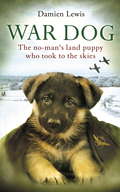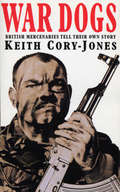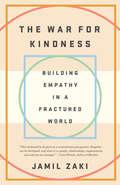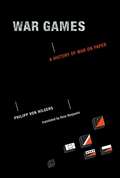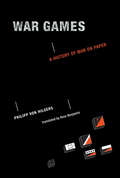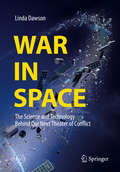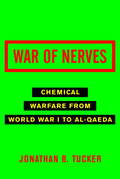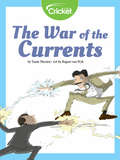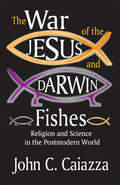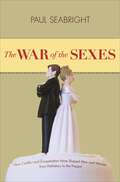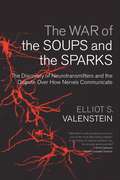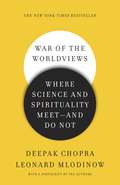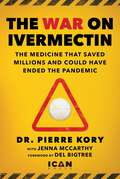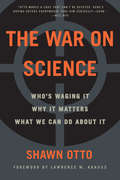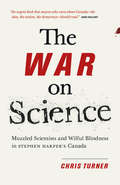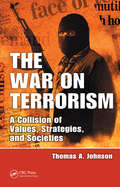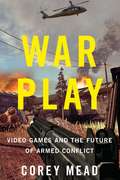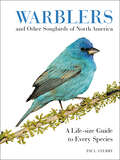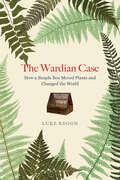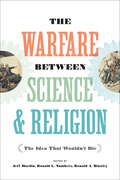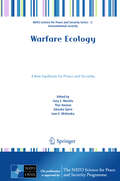- Table View
- List View
War Dog: The no-man's-land puppy who took to the skies
by Damien LewisIn the winter of 1939 in the cold snow of no-man's-land, two loners met and began an extraordinary journey together, one that would bind them for the rest of their lives. One was an orphaned puppy, abandoned by his owners as they fled the approaching Nazi forces. The other, a lost soul of a different sort - a Czech airman, flying for the French Air Force but soon to be bound for the RAF and the country that he would call home. Airman Robert Bozdech stumbled across the tiny German Shepherd after being shot down during a daring mission over enemy lines. Unable to desert his charge, he hid the dog inside his flying jacket as he made his escape. In the months that followed the pair would save each other's lives countless times as they fled France and flew together with Bomber Command; the puppy - which Robert named Ant - becoming the Squadron mascot along the way. Wounded repeatedly in action, shot, facing crash-landings and parachute bailouts, Ant was eventually grounded due to injury. Even then he refused to abandon his duty, waiting patiently beside the runway for his master's return from every sortie.By the end of the war Robert and Ant had become very British war heroes, and Ant was justly awarded the Dickin Medal, the 'Animal VC'. Thrilling and deeply moving, their story will touch the heart of anyone who understands the bond that exists between one man and his dog.
War Dogs: British Mercenaries in Bosnia Tell Their Own Story
by Keith Cory-JonesEqually courageous, equally deadly, the British mercenaries in Bosnia have a story to tell as amazing as 'The One That Got Away', but a story without official blessing. 'War Dogs' follows the fortunes of a gang of eight British mercenaries, a mixed bunch, old and cynical, young and naive, mean and psychotic, two idealists, and the rest just in it for the money. Each of these rogue warriors has his own special skills, strengths and weaknesses, and are all tested in an increasingly terrifying and desperate series of engagements with the enemy. Both sides fight dirty; this is an insider's account of the war in Bosnia that goes far beyond what we read in the newspapers. Not all of them make it back to Britain; one boy with no military experience has told his mother he is working in Eurodisney, and she only finds out the truth when he comes back in a box.
The War for Kindness: Building Empathy in a Fractured World
by Jamil Zaki&“In this masterpiece, Jamil Zaki weaves together the very latest science with stories that will stay in your heart forever.&”—Angela Duckworth, author of GritDon&’t miss Jamil Zaki&’s TED Talk, &“We&’re experiencing an empathy shortage, but we can fix it together,&” online now. Empathy is in short supply. We struggle to understand people who aren&’t like us, but find it easy to hate them. Studies show that we are less caring than we were even thirty years ago. In 2006, Barack Obama said that the United States was suffering from an &“empathy deficit.&” Since then, things seem to have only gotten worse. It doesn&’t have to be this way. In this groundbreaking book, Jamil Zaki shares cutting-edge research, including experiments from his own lab, showing that empathy is not a fixed trait—something we&’re born with or not—but rather a skill that can be strengthened through effort. He also tells the stories of people who embody this new perspective, fighting for kindness in the most difficult of circumstances. We meet a former neo-Nazi who is now helping to extract people from hate groups, ex-prisoners discussing novels with the judge who sentenced them, Washington police officers changing their culture to decrease violence among their ranks, and NICU nurses fine-tuning their empathy so that they don&’t succumb to burnout. Written with clarity and passion, The War for Kindness is an inspiring call to action. The future may depend on whether we accept the challenge.Praise for The War for Kindness&“A wide-ranging practical guide to making the world better.&”—NPR&“Relating anecdotes and test cases from his fellow researchers, news events and the imaginary world of literature and entertainment, Zaki makes a vital case for &‘fighting for kindness.&’ . . . If he&’s right—and after reading The War for Kindness, you&’ll probably think so—Zaki&’s work is right on time.&” —San Francisco Chronicle&“In this landmark book, Jamil Zaki gives us a revolutionary perspective on empathy: Empathy can be developed, and, when it is, people, relationships, organizations, and cultures are changed.&”—Carol Dweck, author of Mindset
War Games: A History of War on Paper
by Philipp Von Hilgers Ross BenjaminFor centuries, both mathematical and military thinkers have used game-like scenarios to test their visions of mastering a complex world through symbolic operations. By the end of World War I, mathematical and military discourse in Germany simultaneously discovered the game as a productive concept. Mathematics and military strategy converged in World War II when mathematicians designed fields of operation. In this book, Philipp von Hilgers examines the theory and practice of war games through history, from the medieval game boards, captured on parchment, to the paper map exercises of the Third Reich. Von Hilgers considers how and why war games came to exist: why mathematical and military thinkers created simulations of one of the most unpredictable human activities on earth. Von Hilgers begins with the medieval rythmomachia, or Battle of Numbers, then reconstructs the ideas about war and games in the baroque period. He investigates the role of George Leopold von Reiswitz's tactical war game in nineteenth-century Prussia and describes the artifact itself: a game board--topped table with drawers for game implements. He explains Clausewitz's emphasis on the "fog of war" and the accompanying element of incalculability, examines the contributions of such thinkers as Clausewitz, Leibniz, Wittgenstein, and von Neumann, and investigates the war games of the German military between the two World Wars. Baudrillard declared this to be the age of simulacra; war games stand contrariwise as simulations that have not been subsumed in absolute virtuality.
War Games: A History of War on Paper (The\mit Press Ser.)
by Philipp Von HilgersThe convergence of military strategy and mathematics in war games, from medieval to modern times.For centuries, both mathematical and military thinkers have used game-like scenarios to test their visions of mastering a complex world through symbolic operations. By the end of World War I, mathematical and military discourse in Germany simultaneously discovered the game as a productive concept. Mathematics and military strategy converged in World War II when mathematicians designed fields of operation. In this book, Philipp von Hilgers examines the theory and practice of war games through history, from the medieval game boards, captured on parchment, to the paper map exercises of the Third Reich. Von Hilgers considers how and why war games came to exist: why mathematical and military thinkers created simulations of one of the most unpredictable human activities on earth.Von Hilgers begins with the medieval rythmomachia, or Battle of Numbers, then reconstructs the ideas about war and games in the baroque period. He investigates the role of George Leopold von Reiswitz's tactical war game in nineteenth-century Prussia and describes the artifact itself: a game board–topped table with drawers for game implements. He explains Clausewitz's emphasis on the “fog of war” and the accompanying element of incalculability, examines the contributions of such thinkers as Clausewitz, Leibniz, Wittgenstein, and von Neumann, and investigates the war games of the German military between the two World Wars. Baudrillard declared this to be the age of simulacra; war games stand contrariwise as simulations that have not been subsumed in absolute virtuality.
The War in Outer Space (Tom Swift III, Book #4)
by Victor AppletonWhen Tom builds the marvelous new hyper-drive spacecraft, Exedra, he zooms off to a distant part of the galaxy and a dangerous, challenging adventure. With his friends, Ben and Anita, and his trusty robot, Aristotle, Tom meets a peace-loving but frightened race of insectoids known as the Skree. When Tom Learns that the intelligent Skree are being attacked by a vicious and relentless race of humanoids, the Chutans, he is determined to help them. Tom and his friends face almost certain death as they fight the Chutans to save Earth from destruction!
War in Space: The Science and Technology Behind Our Next Theater of Conflict (Springer Praxis Books)
by Linda DawsonWith the recent influx of spaceflight and satellite launches, the region of outer space has become saturated with vital technology used for communication and surveillance and the functioning of business and government. But what would happen if these capabilities were disrupted or even destroyed? How would we react if faced with a full-scale blackout of satellite communications? What can and has happened following the destruction of a satellite? In the short term, the aftermath would send thousands of fragments orbiting Earth as space debris. In the longer term, the ramifications of such an event on Earth and in space would be alarming, to say the least. This book takes a look at such crippling scenarios and how countries around the world might respond in their wake. It describes the aggressive actions that nations could take and the technologies that could be leveraged to gain power and control over assets, as well as to initiate war in the theater of outer space. The ways that a country's vital capabilities could be disarmed in such a setting are investigated. In addition, the book discusses our past and present political climate, including which countries currently have these abilities and who the aggressive players already are. Finally, it addresses promising research and space technology that could be used to protect us from those interested in destroying the world's vital systems.
War of Nerves
by Jonathan B. TuckerStatesmen, generals, and diplomats have long debated the military utility and morality of chemical warfare. In 1925, the use of chemical weapons in war was prohibited by international treaty; in 1997 the ban on the use of chemical weapons was extended to cover their development, production, and stockpiling. Nevertheless, Iraq employed chemical weapons on a large scale as recently as the 1980s, first during its eight-year war with Iran and then against its rebellious Kurdish minority. InWar of Nerves, Jonathan Tucker, a leading expert on chemical and biological weapons, writes about chemical warfare from World War I to the present. The author makes clear how, at the turn of the twentieth century, the large-scale use of toxic chemicals on the battlefield became feasible and cheap; how Germany first developed and employed toxic weapons during World War I, burying some 6,000 cylinders (containing 168 tons of chlorine) opposite the Allied trenches defending the town of Ypres, in Belgium. German troops simultaneously opened the chlorine cylinders, panicking two French divisions and tearing a gap four miles wide in the Ypres front. Chemical warfare had begun: five months later, the Allies retaliated with their own use of chlorine gas. By the end of the war, chemical warfare had inflicted roughly one million casualties, 90,000 of them fatal. Tucker writes about the synthesis of the first nerve agent—Tabun—in 1936 by a German industrial chemist developing new pesticides how its high toxicity made it unusable as a pesticide but viable as a weapon for the Nazi regime. A few years later, two even more toxic nerve agents—Sarin and Soman—were developed for military use. Hitler never employed this secret weapon; German intelligence concluded—incorrectly—that the Allies had developed a similar capability. Following World War II, we see the rise of a Cold War chemical competition between the United States and the Soviet Union that paralleled the nuclear arms race, as each pursued the secrets of the German nerve agents; how the United States and Britain planned to mass-produce Sarin (only the United States did); how the superpowers developed and mass-produced V-agents, a new generation of nerve agents of extraordinary potency; and how nerve agents spread to the Third World, including their suspected use by Egypt during the Yemen Civil War (1963—1967), as well as Iraq’s use of nerve agents in its war against Iran and on its own people. Iraq’s use of nerve agents hastened the negotiation of an international treaty banning the use of chemical weapons, which went into effect in 1997. Although the treaty now has more than 175 member-states, al-Qaeda and related terrorist groups are seeking to acquire nerve agents. In this important and revelatory book, Jonathan Tucker makes clear that we are at a crossroads that could lead either to the further spread of these weapons or to their ultimate abolition. From the Hardcover edition.
The War of the Currents
by Tania TherienThomas Edison first developed direct current for New York City, but was challenged by Nikola Tesla, who believed his alternating current was a better solution.
The War of the Jesus and Darwin Fishes: Religion and Science in the Postmodern World
by John C. CaiazzaThis volume's title stems from an observable and seemingly amusing phenomenon--the placement of fish symbols on the rear of automobiles. There are two kinds: one a fish outline with a cross, exhibited by Christians; the other a fish outline filled with the word "evolution," with little legs attached underneath. These symbols manifest the cultural war between religion and science, a clash that draws from nineteenth-century conflicts over evolution roots in the Enlightenment.Today's cultural environment is a result of the internationalization of communication, labor, money, and commerce. This global culture emphasizes tolerance and acceptance of all peoples and traditions, but it also demands a moral and intellectual relativism that rejects "master narratives," including religious tradition as well as scientific theory. In some respects, the postmodern environment is caused by science itself, by the development of postmodern science, its nineteenth-century adversarial stance toward religion now somewhat softened. Among new developments are the historical understanding of science, renewed appreciation of the troubled careers of scientists, and "God" talk among physicists and psychologists. Both science and religion are being overwhelmed by new levels of technology, which is becoming the premier element of contemporary culture.The conflict between science and religion is being resolved in the form of a dynamic. Religion and science are both ways of giving moral and intellectual order to the universe, enabling mankind to cope with a chaotic universe and live well. Both religious critics and scientific researchers have attacked and analyzed pornography, which has become a prominent characteristic of our culture. Both share contemporary sensitivity to individual opinions and protection of the individual from social control. Both science and religion share a sense that postmodern culture lacks structure. Caiazza shows how renewed attention to religious and scientific insights can resolve longstanding conflicts, providing postmodern society with a vision of tolerable order.
The War of the Sexes: How Conflict and Cooperation Have Shaped Men and Women from Prehistory to the Present
by Paul SeabrightHow our stone-age brains made modern society, and why it matters for relationships between men and womenAs countless love songs, movies, and self-help books attest, men and women have long sought different things. The result? Seemingly inevitable conflict. Yet we belong to the most cooperative species on the planet. Isn't there a way we can use this capacity to achieve greater harmony and equality between the sexes? In The War of the Sexes, Paul Seabright argues that there is—but first we must understand how the tension between conflict and cooperation developed in our remote evolutionary past, how it shaped the modern world, and how it still holds us back, both at home and at work.Drawing on biology, sociology, anthropology, and economics, Seabright shows that conflict between the sexes is, paradoxically, the product of cooperation. The evolutionary niche—the long dependent childhood—carved out by our ancestors requires the highest level of cooperative talent. But it also gives couples more to fight about. Men and women became experts at influencing one another to achieve their cooperative ends, but also became trapped in strategies of manipulation and deception in pursuit of sex and partnership. In early societies, economic conditions moved the balance of power in favor of men, as they cornered scarce resources for use in the sexual bargain. Today, conditions have changed beyond recognition, yet inequalities between men and women persist, as the brains, talents, and preferences we inherited from our ancestors struggle to deal with the unpredictable forces unleashed by the modern information economy.Men and women today have an unprecedented opportunity to achieve equal power and respect. But we need to understand the mixed inheritance of conflict and cooperation left to us by our primate ancestors if we are finally to escape their legacy.
The War of the Soups and the Sparks: The Discovery of Neurotransmitters and the Dispute Over How Nerves Communicate
by Elliot ValensteinLike the cracking of the genetic code and the creation of the atomic bomb, the discovery of how the brain's neurons work is one of the fundamental scientific developments of the twentieth century. The discovery of neurotransmitters revolutionized the way we think about the brain and what it means to be human yet few people know how they were discovered, the scientists involved, or the fierce controversy about whether they even existed. The War of the Soups and the Sparks tells the saga of the dispute between the pharmacologists, who had uncovered the first evidence that nerves communicate by releasing chemicals, and the neurophysiologists, experts on the nervous system, who dismissed the evidence and remained committed to electrical explanations.The protagonists of this story are Otto Loewi and Henry Dale, who received Nobel Prizes for their work, and Walter Cannon, who would have shared the prize with them if he had not been persuaded to adopt a controversial theory (how that happened is an important part of this history). Valenstein sets his story of scientific discovery against the backdrop of two world wars and examines the fascinating lives of several scientists whose work was affected by the social and political events of their time. He recounts such stories as Loewi's arrest by Nazi storm troopers and Dale's efforts at helping key scientists escape Germany. The War of the Soups and the Sparks reveals how science and scientists work. Valenstein describes the observations and experiments that led to the discovery of neurotransmitters and sheds light on what determines whether a novel concept will gain acceptance among the scientific community. His work also explains the immense importance of Loewi, Dale, and Cannon's achievements in our understanding of the human brain and the way mental illnesses are conceptualized and treated.
War of the Worldviews: Where Science and Spirituality Meet -- and Do Not
by Deepak Chopra Leonard MlodinowTwo bestselling authors first met in a televised Caltech debate on “the future of God,” one an articulate advocate for spirituality, the other a prominent physicist. This remarkable book is the product of that serendipitous encounter and the contentious—but respectful—clash of worldviews that grew along with their friendship. InWar of the Worldviewsthese two great thinkers battle over the cosmos, evolution and life, the human brain, and God, probing the fundamental questions that define the human experience. How did the universe emerge? What is the nature of time? What is life? Did Darwin go wrong? What makes us human? What is the connection between mind and brain? Is God an illusion? This extraordinary book will fascinate millions of readers of science and spirituality alike, as well as anyone who has ever asked themselves, What does it mean that I am alive? From the Hardcover edition.
War on Ivermectin: The Medicine that Saved Millions and Could Have Ended the Pandemic
by Pierre Kory Jenna McCarthyBig Pharma and health agencies cry, &“Don&’t take ivermectin!&” A media storm follows. Why then, does the science say the opposite?&” Ivermectin is a dirty word in the media. It doesn&’t work. It&’s a deadly horse dewormer. Prescribe or promote it and you&’ll be called a right-wing quack, be banned from social media, or lose your license to practice medicine. And yet, entire countries wiped out the virus with it, and more than ninety-five studies now show it to be unequivocally effective in preventing and treating Covid-19. If it didn&’t work, why was there a coordinated global campaign to cancel it? What&’s the truth about this decades-old, Nobel Prize-winning medication? The War on Ivermectin is the personal and professional narrative of Dr. Pierre Kory and his crusade to recommend a safe, inexpensive, generic medicine as the key to ending the pandemic. Written with Jenna McCarthy, Dr. Kory&’s story chronicles the personal attacks, professional setbacks, and nefarious efforts of the world&’s major health agencies and medical journals to dismiss and deny ivermectin&’s efficacy. Part personal narrative, part scathing expose, The War on Ivermectin highlights the catastrophic impacts of the mass media censorship and relentless propaganda that led to the greatest humanitarian crisis in history. Although numerous studies and epidemiologic data have shown that millions of lives were saved globally with the systematic use of ivermectin, many more millions perished. This carnage was the direct result of what Dr. Kory eventually discovered to be the pharmaceutical industry&’s silent but deadly war on generic medicines and the corrupt, captured medical and media systems that allow it to continue. For anyone who thought Covid-19 was the enemy, Dr. Kory&’s book will leave no doubt that the true adversary in this war is a collective cabal of power-hungry elites who put profits over people and will stop at nothing in their quest for control.The War on Ivermectin is published through ICAN PRESS, an imprint of Skyhorse Publishing. ICAN (Informed Consent Action Network) is a nonprofit organization investigating the safety of medical procedures, pharmaceutical drugs, and vaccines while advocating for people&’s right to informed consent.
The War on Science: Who's Waging It, Why It Matters, What We Can Do About It
by Shawn Lawrence Otto"Wherever the people are well informed," Thomas Jefferson wrote, "they can be trusted with their own government." But what happens when they are not? In every issue of modern society--from climate change to vaccinations, transportation to technology, health care to defense--we are in the midst of an unprecedented expansion of scientific progress and a simultaneous expansion of danger. At the very time we need them most, scientists and the idea of objective knowledge are being bombarded by a vast, well-funded, three-part war on science: the identity politics war on science, the ideological war on science, and the industrial war on science. The result is an unprecedented erosion of thought in Western democracies as voters, policymakers, and justices actively ignore the evidence from science, leaving major policy decisions to be based more on the demands of the most strident voices.Shawn Otto's compelling new book investigates the historical, social, philosophical, political, and emotional reasons why evidence-based politics are in decline and authoritarian politics are once again on the rise on both left and right, and provides some compelling solutions to bring us to our collective senses, before it's too late.
The War on Science
by Chris TurnerA passionate and meticulously researched argument against the Harper government's war on scienceIn this arresting and passionately argued indictment, award-winning journalist Chris Turner contends that Stephen Harper's attack on basic science, science communication, environmental regulations, and the environmental NGO community is the most vicious assault ever waged by a Canadian government on the fundamental principles of the Enlightenment. From the closure of Arctic research stations as oil drilling begins in the High Arctic to slashed research budgets in agriculture, dramatic changes to the nation's fisheries policy, and the muzzling of government scientists, Harper's government has effectively dismantled Canada's long-standing scientific tradition. Drawing on interviews with scientists whose work has been halted by budget cuts and their colleagues in an NGO community increasingly treated as an enemy of the state, The War on Science paints a vivid and damning portrait of a government that has abandoned environmental stewardship and severed a nation.
The War on Terrorism: A Collision of Values, Strategies, and Societies
by Thomas A. JohnsonIn order to eradicate terrorism, our nation must go beyond merely shoring up military strength. It must also effectively confront the fundamentalist ideology that fuels and supports the terrorists. The War on Terrorism: A Collision of Values, Strategies, and Societies operates on the premise that the violent rejection of globalization at the root o
War Play
by Corey MeadA behind-the-scenes look at how the military uses video game technology to train soldiers, treat veterans, and entice new recruits How does the U.S. military train its soldiers for new forms of armed conflict, all within the constraints of diminished defense budgets? Increasingly, the answer is cutting-edge video game technology. Corey Mead shows us training sessions where soldiers undertake multiplayer "missions" that test combat skills, develop unit cohesion, and teach cultural awareness. He immerses himself in 3-D battle simulations so convincing that they leave his heart racing. And he shows how the military, which has shaped American education more than any other force over the last century, fuels the adoption of games as learning tools--and recruitment come-ons. Mead also details how the military uses games to prepare soldiers for their return to the home front and to treat PTSD. Military-funded researchers were closely involved with the computing advances that led to the invention of the Internet. Now, as Mead proves, we are poised at the brink of a similar explosion in game technology. War Play reveals that many of tomorrow's teaching tools, therapies, and entertainments can be found in today's military.
Warblers and Other Songbirds of North America: A Life-size Guide to Every Species
by Paul SterryA stunning full-color photographic field guide of 285 species of North American songbirds and warblers, captured in glorious life-sized detail and featuring concise descriptions, location maps, and useful facts for both experienced birdwatchers and armchair ornithologists alike.Birds such as the Acadian Flycatcher, Golden-crowned Kinglet, Indigo Bunting, Northern Mockingbird, Pyrrhuloxia, Rock Wren, Song Sparrow, Tree Swallow, and the Yellow Throated Warbler are known for their elaborate songs produced by their highly developed vocal organs. Warblers and Other Songbirds of North America is a breathtaking collection of 285 species of these beautiful, melodious creatures, the largest number of species in a single field guide about North American songbirds.Arranged by region and taxonomic order, every songbird is depicted life-sized; each photograph is accompanied by a short description with essential information on identification and the particular species, habits, and behavior. Every species entry also includes a map showing where the species can be found, as well as a fact grid listing key details such as common and scientific name, length, food, habitat, status, and voice. Inside you'll find fun facts, including:Songbirds are members of the order Passeriformes, the most varied group of birds both in terms of numbers of species and diversity of appearance and habit preferences.Songbirds have feet that allow them to perch with ease, with three toes pointing forward and one facing back.Songbirds are extremely vocal; some male species are among the finest songsters in the bird world.Every photograph is gloriously detailed and chosen to show each species’ unique identification features and typical postures. Packed in a convenient portable size, Warblers and Other Songbirds of North America is ideal for the experienced birdwatcher, the aspiring naturalist, and every bird lover.
The Wardian Case: How a Simple Box Moved Plants and Changed the World
by Luke KeoghRoses, jasmine, fuchsia, chrysanthemums, and rhododendrons bloom in gardens across the world, and yet many of the most common varieties have roots in Asia. How is this global flowering possible? In 1829, surgeon and amateur naturalist Nathaniel Bagshaw Ward placed soil, dried leaves, and the pupa of a sphinx moth into a sealed glass bottle, intending to observe the moth hatch. But when a fern and meadow grass sprouted from the soil, he accidentally discovered that plants enclosed in glass containers could survive for long periods without watering. After four years of experimentation in his London home, Ward created traveling glazed cases that would be able to transport plants around the world. Following a test run from London to Sydney, Ward was proven correct: the Wardian case was born, and the botanical makeup of the world’s flora was forever changed. In our technologically advanced and globalized contemporary world, it is easy to forget that not long ago it was extremely difficult to transfer plants from place to place, as they often died from mishandling, cold weather, and ocean salt spray. In this first book on the Wardian case, Luke Keogh leads us across centuries and seas to show that Ward’s invention spurred a revolution in the movement of plants—and that many of the repercussions of that revolution are still with us, from new industries to invasive plant species. From the early days of rubber, banana, tea, and cinchona cultivation—the last used in the production of the malaria drug quinine—to the collecting of beautiful and exotic flora like orchids in the first great greenhouses of the United States Botanic Garden in Washington, DC, and England’s Royal Botanic Gardens, Kew, the Wardian case transformed the world’s plant communities, fueled the commercial nursery trade and late nineteenth-century imperialism, and forever altered the global environment.
Wardlaw's Contemporary Nutrition: A Functional Approach
by Angela L. Collene Anne M. Smith Colleen SpeesContemporary Nutrition: A Functional Approach is an alternate version of Smith, Collene, Spees Contemporary Nutrition, offering a unique approach by organizing vitamins and minerals within the context of physiological functions and the health conditions they influence. Current research is at the core of the fifth edition, with revised statistics, incorporation of new results of clinical trials, and updated recommendations. The text provides students who lack a strong science background the ideal balance of reliable nutrition information and practical consumer-oriented knowledge. Always looking to make the content relevant to learners, the authors highlight health conditions, medications, food products, and supplements students or members of their families may be using. With their friendly writing style, the authors act as the student’s personal guide to dispelling common misconceptions and to gaining a solid foundation for making informed nutrition choices.
Wardlaw's Perspectives In Nutrition
by Gordon M. Wardlaw Carol Byrd-Bredbenner Jacqueline R. Berning Danita S. Kelley Jackie AbbotWardlaw’s Perspectives in Nutrition has the richly deserved reputation of providing an accurate, current, in-depth, and thoughtful introduction to the dynamic field of nutrition. The authors have endeavored to build upon this tradition of excellence by enriching this edition for both students and instructors. Their passion for nutrition, genuine desire to promote student learning, and their commitment to scientific accuracy, coupled with constructive comments from instructors and students, guided them in this revision.
The Warfare between Science and Religion: The Idea That Wouldn't Die
by Edited by Jeff Hardin, Ronald L. Numbers, and Ronald A. BinzleyWhy is the idea of conflict between science and religion so popular in the public imagination?The "conflict thesis"—the idea that an inevitable and irreconcilable conflict exists between science and religion—has long been part of the popular imagination. In The Warfare between Science and Religion, Jeff Hardin, Ronald L. Numbers, and Ronald A. Binzley have assembled a group of distinguished historians who explore the origin of the thesis, its reception, the responses it drew from various faith traditions, and its continued prominence in public discourse. Several essays in the book examine the personal circumstances and theological idiosyncrasies of important intellectuals, including John William Draper and Andrew Dickson White, who through their polemical writings championed the conflict thesis relentlessly. Other essays consider what the thesis meant to different religious communities, including evangelicals, liberal Protestants, Roman Catholics, Eastern Orthodox Christians, Jews, and Muslims. Finally, essays both historical and sociological explore the place of the conflict thesis in popular culture and intellectual discourse today. Based on original research and written in an accessible style, the essays in The Warfare between Science and Religion take an interdisciplinary approach to question the historical relationship between science and religion. This volume, which brings much-needed perspective to an often bitter controversy, will appeal to scholars and students of the histories of science and religion, sociology, and philosophy.Contributors: Thomas H. Aechtner, Ronald A. Binzley, John Hedley Brooke, Elaine Howard Ecklund, Noah Efron, John H. Evans, Maurice A. Finocchiaro, Frederick Gregory, Bradley J. Gundlach, Monte Harrell Hampton, Jeff Hardin, Peter Harrison, Bernard Lightman, David N. Livingstone, David Mislin, Efthymios Nicolaidis, Mark A. Noll, Ronald L. Numbers, Lawrence M. Principe, Jon H. Roberts, Christopher P. Scheitle, M. Alper Yalçinkaya
The Warfare between Science & Religion: The Idea That Wouldn't Die
by Edited by Jeff Hardin, Ronald L. Numbers, and Ronald A. BinzleyA “very welcome volume” of essays questioning the presumption of irreconcilable conflict between science and religion (British Journal for the History of Science).The “conflict thesis”—the idea that an inevitable, irreconcilable conflict exists between science and religion—has long been part of the popular imagination. The Warfare between Science and Religion assembles a group of distinguished historians who explore the origin of the thesis, its reception, the responses it drew from various faith traditions, and its continued prominence in public discourse.Several essays examine the personal circumstances and theological idiosyncrasies of important intellectuals, including John William Draper and Andrew Dickson White, who through their polemical writings championed the conflict thesis relentlessly. Others consider what the thesis meant to different religious communities, including evangelicals, liberal Protestants, Roman Catholics, Eastern Orthodox Christians, Jews, and Muslims. Finally, essays both historical and sociological explore the place of the conflict thesis in popular culture and intellectual discourse today.Based on original research and written in an accessible style, the essays in The Warfare between Science and Religion take an interdisciplinary approach to question the historical relationship between science and religion, and bring much-needed perspective to an often-bitter controversy.Contributors include: Thomas H. Aechtner, Ronald A. Binzley, John Hedley Brooke, Elaine Howard Ecklund, Noah Efron, John H. Evans, Maurice A. Finocchiaro, Frederick Gregory, Bradley J. Gundlach, Monte Harrell Hampton, Jeff Hardin, Peter Harrison, Bernard Lightman, David N. Livingstone, David Mislin, Efthymios Nicolaidis, Mark A. Noll, Ronald L. Numbers, Lawrence M. Principe, Jon H. Roberts, Christopher P. Scheitle, M. Alper Yalçinkaya
Warfare Ecology
by Gary E. Machlis Jean E. Mckendry Thor Hanson Zdravko ŠpirićThe purpose of this book is specific and ambitious: to outline the distinctive elements, scope, and usefulness of a new and emerging field of applied ecology named warfare ecology. Based on a NATO Advanced Research Workshop held on the island of Vieques, Puerto Rico, the book provides both a theoretical overview of this new field and case studies that range from mercury contamination during World War I in Slovenia to the ecosystem impacts of the Palestinian occupation, and from the bombing of coral reefs of Vieques to biodiversity loss due to violent conflicts in Africa. Warfare Ecology also includes reprints of several classical papers that set the stage for the new synthesis described by the authors. Written for environmental scientists, military and humanitarian relief professionals, conservation managers, and graduate students in a wide range of fields, Warfare Ecology is a major step forward in understanding the relationship between war and ecological systems.
